 |
Home | Charity | Feedback |
India:
Auli,
Badrinath,
Ghangria,
Haridwar,
Kedarnath,
Mana,
Rishikesh
Badrinath & Kedarnath, India: Pilgrim’s progress by Prakash Bang, Editor in Chief 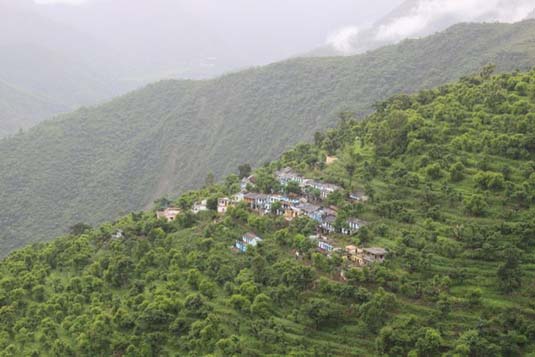 For the devote Hindu, a trip to Badrinath & Kedarnath is mission accomplished. Badrinath is one of the four Dhams. There are 4 Dhams that devote Hindu must visit in his lifetime; Rameshwar in the South, Dwarka in the West, Jagganathpuri in the East and Badrinath in the North. During the early century, the road to Badrinath was quite a tricky one. Pilgrims snaked their way on the edge of the Himalayan mountain range and crossed various rivers in cane baskets that were attached to overhead ropes. One wrong step and that was it. There was no coming back. Reason why, Badrinath was visited in the twilight years of one's life. Family back home celebrated pilgrim's safe return from Badrinath. The tradition still continues. These days, thanks to good roads, albeit single track, the journey to the holy towns is quite safe and indeed beautiful. Kedarnath is one of the 12 jyotirlingas (refer to my blog on Bhimashakar; Ajanta & Ellora). Jyotirlangas are shrines belonging to Lord Shiva who as per Indian mythology controls death and is said to reside in Kailas, Himalayas. 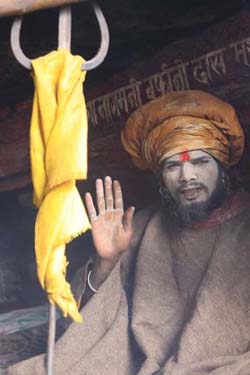 For the atheist, the tour is a wonderful excuse to be with nature. Crisp mountain air,
rivers that run waters from melting glaciers, lush green forests and comfortable hotels make for a great holiday. There's plenty for the trekkers too.
For the atheist, the tour is a wonderful excuse to be with nature. Crisp mountain air,
rivers that run waters from melting glaciers, lush green forests and comfortable hotels make for a great holiday. There's plenty for the trekkers too.
Delhi is an ideal gateway city. Our group assembled at Delhi airport. We hired a bus that took us all the way up to Kedarnath and got us back safe to Delhi at the end of the 10th day. It's a good idea to hire from Delhi a car or a bus if more passengers are around. Special permits are issued to taxi operators to arrange for the travels in the hills. Drivers with experience to drive these roads are an absolute must. Generally speaking, a package can be booked at a very reasonable cost that include travel, stay and vegetarian food. We were in safe hands of Mr Mohit Gupta of Alpine Adventures who owns a Trekking & Tour Company and has excellent arrangements to make the tour of the valley comfortable. He and his team of 2 assistants were with our group at all times. I was keen in exploring the Valley of Flowers hence a little detour was needed. My trip lasted for 10 full days and the route was from Delhi to Haridwar (210 kms); Haridwar to Joshimath (275 kms); Joshimath to Govindghat (20 kms); then a trek of 14 kms from Govindghat to Ghangria; then a trek of 6 kms from Ghangria to Valley of Flowers; trek back to Govindghat and then to Badrinath (24 kms); Badrinath to Rudraprayag (160 kms); Rudraprayag to Guptakashi (40 kms); Guptkashi to Gaurikund (34 kms); then a trek of 14 kms to Kedarnath; trek back to Gaurikund and onwards to Rudraprayag; Rudraprayag to Haridwar and finally from Haridwar to Delhi airport. 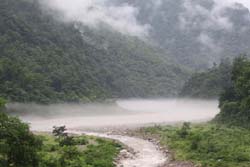 Let not the distances in kms. deceive you. Remember, it's a hilly road. At the best you will cover not more than 30 kms per hour. Moreover, the final leg to Badrinath is a one way route, meaning, traffic from either side is controlled. You need to check the times the gates open to avoid the wait at the control gate. 3 kms from Badrinath is village Mana. A quaint little town and the last destination where civilians can go. Beyond Mana are mountains and the China border. Mana has the origin of River Saraswati and is also a place wherein Lord Ganesha (the elephant headed God) scripted the Vedas as narrated by his Guru Vyas.
Let not the distances in kms. deceive you. Remember, it's a hilly road. At the best you will cover not more than 30 kms per hour. Moreover, the final leg to Badrinath is a one way route, meaning, traffic from either side is controlled. You need to check the times the gates open to avoid the wait at the control gate. 3 kms from Badrinath is village Mana. A quaint little town and the last destination where civilians can go. Beyond Mana are mountains and the China border. Mana has the origin of River Saraswati and is also a place wherein Lord Ganesha (the elephant headed God) scripted the Vedas as narrated by his Guru Vyas.
While the treks are paved, they are steep. If walking is difficult, one can opt for a palanquin or a pony or simply be backpacked by a porter! I was appalled by the strength and stamina of the porters. These mountain men looked fragile but they had real substance! Running up and down the steep with 80 kgs of load is not funny. To be honest, I felt a little guilty seeing these men carry people like head load. Thankfully, I was OK with my feet. I did use the pony to climb the Kedarnath trek as I had fever and was on antibiotics. Probably, wandering in the rains in the Valley of Flowers took my juice away. No complaints. It was worth the pain. 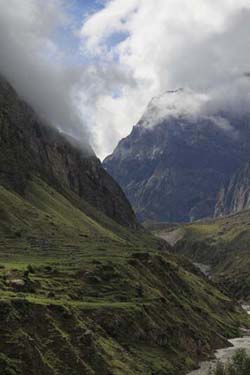 As we left Haridwar, and after crossing Rishikesh, the climb began. As it had rained the previous evening, fog, mist and low flying clouds made for a beautiful blanket covering the hills and the rivers below. Had I been a poet, the journey would have certainly inspired me to ink my thoughts. Anyway, since that was not to be, my camera somewhat filled the creative void.
As we left Haridwar, and after crossing Rishikesh, the climb began. As it had rained the previous evening, fog, mist and low flying clouds made for a beautiful blanket covering the hills and the rivers below. Had I been a poet, the journey would have certainly inspired me to ink my thoughts. Anyway, since that was not to be, my camera somewhat filled the creative void.
As we moved up, we negotiated 5 major river confluences. River Alaknanda & Bhagirathi to make The Ganges at Devprayag; River Alaknanda & Mandakini at Rudraprayag; River Alaknanada & Pindhari at Karnaprayag; River Alaknanda & Nandakini at Nandprayag and finally River Alaknanda & Dhauli Ganga at Vishnuprayag. Each of these prayag (confluences) is considered auspicious and a dip in the icy waters is recommended. I avoided the temptation. All along the journey, River Alaknanda flows, with a roaring sound, at the foothills. The milky white pristine waters are quite soothing. The journey doesn't seem to tire you. While rivers ran at the foothills, snow covered the peaks. I was lucky to witness 8 Himalayan peaks from various locations. The peaks of Barmal, Dronagiri and Nandadevi (India's 2nd highest peak) were visible from Auli. One can reach Auli top from Joshimath by a ropeway, claimed to be amongst the longest (4.11 kms) in the world. The return trip costs Rs 500 each and lasts for 22 to 25 minutes one way. Auli is a popular ski-destination with excellent resorts atop. We spent just a couple of hours on top and returned. The weather Gods were kind, else, I would have missed viewing the peaks. I certainly recommend a visit to Auli - at least for a day if not more. Trekkers will find over 40 trails from Auli. As we gained altitude the trees changed from apples to walnuts to chestnuts to oak and to pine. Different altitudes favour different species of plant life. 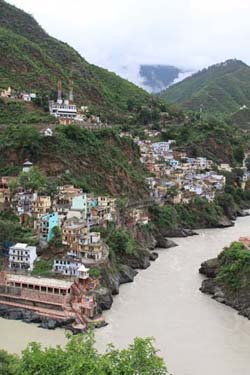 From Kedarnath I could see the peaks of Meru and Sumeru. From Badrinath I got the beautiful view of Neelkanth, Nar and Narayan peaks and from Valley of Flowers I could see the Raktban peak.
From Kedarnath I could see the peaks of Meru and Sumeru. From Badrinath I got the beautiful view of Neelkanth, Nar and Narayan peaks and from Valley of Flowers I could see the Raktban peak.
The climb to Valley of Flowers commences from Ghangria which is the base camp. Valley of Flowers is a protected National Park and is declared a biosphere zone. As such vehicles and ponies are not allowed. One has to trek up on foot or use the services of porters to carry you around. The Valley of Flowers starts after a climb of 3 kms. Thereafter, it's a flat and one can walk all the way to the end of the valley which is about 7 kms in length and about 3 kms wide. The valley is home to over 300 species of flowers. The flowers are in full bloom, after the snow melts. The best months to visit the valley are July & August. Of course, over 50 species would still be visible up to September end. Since it was drizzling when I was around, I could walk only for 3 kms. in the valley There was no stopping, but the mood just wasn't there to complete the round. The Eco Development Committee at Ghangria has an informative 20-minute film on the Valley of Flowers which is shown every evening at regular intervals. Cost is just Rs 20, and I certainly recommend a view. I have grouped 29 pictures shot in the Valley of Flowers and they appear last in the photo album. Just so you know, if you have the time and the energy, you can also plan to trek to Shri Hemkund Sahib from Ghangria. 7 kms up stands this beautiful location which is the seat of one of the Sikh Gurus. This is a sacred location for the followers of the Sikh Faith. I am told the route is more beautiful than the Valley of Flowers. Since the altitude of Shri Hemkund Sahib is nearly 15,000 feet above MSL, the location is home to some exotic varieties of flowers including the Bramhakamal (a rare lotus). I missed the show. 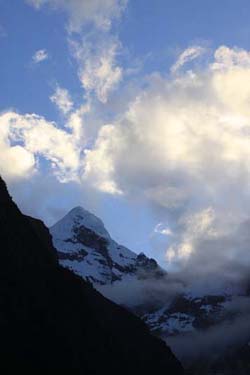 In fitness of things, I must briefly tell you about the rituals that a Hindu must complete when visiting the holy towns of Badrinath and Kedarnath. It's all about Moksha - of breaking away the ties with the materialistic world and being with the Gods in spirit and soul. After bathing in the soothing hot natural geysers, it's the duty of a son to offer prayers at Badrinath to release the spirits, from worldly ties, of all those dead in his family. By offering prayers and alms at Bramhakapal, a specific location on the banks of River Alaknanda in Badrinath, the departed souls would ever rest in peace. Amen. While ideally, every Hindu son should do the kriya (procedure/ritual) at Badrinath for the ultimate solace, prayers are also offered to the dead at Haridwar on the banks of River Ganges. In fact, the ashes after cremating the dead are immersed in the Ganges.
In fitness of things, I must briefly tell you about the rituals that a Hindu must complete when visiting the holy towns of Badrinath and Kedarnath. It's all about Moksha - of breaking away the ties with the materialistic world and being with the Gods in spirit and soul. After bathing in the soothing hot natural geysers, it's the duty of a son to offer prayers at Badrinath to release the spirits, from worldly ties, of all those dead in his family. By offering prayers and alms at Bramhakapal, a specific location on the banks of River Alaknanda in Badrinath, the departed souls would ever rest in peace. Amen. While ideally, every Hindu son should do the kriya (procedure/ritual) at Badrinath for the ultimate solace, prayers are also offered to the dead at Haridwar on the banks of River Ganges. In fact, the ashes after cremating the dead are immersed in the Ganges.
At Kedarnath, devotees are supposed to be generous with alms. It's common to offer food and clothing to the needy and the poor. There are plenty to be seen around the Kedarnath temple premises. So much has been offered to the needy that they have now become choosy. At times they decline the alms offered by the devotees and actually demand for other things… all about demand and supply. On our return leg, we spent a couple of hours in Rishikesh and visited the ancient Laxman temple and Laxman Zhula - a suspension bridge over the mighty Ganges. Zhula means a swing. This bridge actually sways as one walks along… safe nonetheless. Our last night was spent in Haridwar. I recommend to witness the evening (time is not fixed, depends on the sunset) ceremony of worshipping (called Ganga Aarti) the River Ganges with lighted oil lamps. Hundreds of thousands of devotees sit patiently on the banks of the Ganges to see the ritual that lasts for about 5 minutes. It's customary to immerse in the waters at Har Ki Pauri to wash away the sins you might have committed so far! 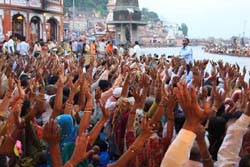 My hotels during the journey were: Gyan Heritage in Haridwar (excellent); Kamet in Joshimath (bad - avoid by all means and at all costs); Priya in Ghangria (average but excellent service); Dwarikesh in Badrinath (excellent but service could be
better); Vishwanath in Guptakashi (average); Punjab Sind Awas in Kedarnath (excellent) and Shangrila in Rudraprayag (excellent). Since most of the places are holy towns, only vegetarian food is cooked. Since I was part of a group, I am not sure about individual room tariffs but a good guess would be around Rs 1500 - Rs 2000 for an ensuite double room. At the time of writing, US$ 1 fetched Indian Rs 49.
My hotels during the journey were: Gyan Heritage in Haridwar (excellent); Kamet in Joshimath (bad - avoid by all means and at all costs); Priya in Ghangria (average but excellent service); Dwarikesh in Badrinath (excellent but service could be
better); Vishwanath in Guptakashi (average); Punjab Sind Awas in Kedarnath (excellent) and Shangrila in Rudraprayag (excellent). Since most of the places are holy towns, only vegetarian food is cooked. Since I was part of a group, I am not sure about individual room tariffs but a good guess would be around Rs 1500 - Rs 2000 for an ensuite double room. At the time of writing, US$ 1 fetched Indian Rs 49.
Whilst discussing Badrinath and Kedarnath, you are likely to be advised to add a couple of days to visit Gangotri (origin of River Bhagirathi) & Jamnotri (origin of River Yamuna). While there's a motorable road to Gangotri, the trek, I am told, to Jamnotri is pretty difficult. I met many pilgrims on the way who had visited these locations and were quite delighted. Well, I missed it. You shouldn't. Badrinath & Kedarnath Image Gallery  Photo viewer Photo viewer
|
|
|
Home |
Charity |
Feedback
Privacy Policy | Terms of Usage © YoGoYo.com. All rights reserved. |

































































